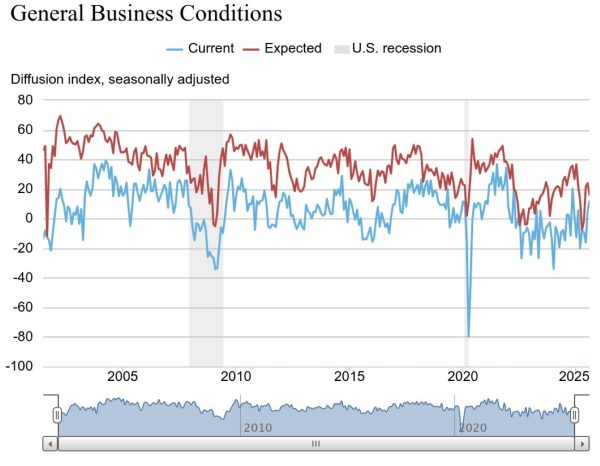Get our email updates
Stay up-to-date on the companies, people and issues that impact businesses in Syracuse, Central New York and beyond.
What's New
Upcoming Events
CNYBJ Job Board

New York manufacturing index hits highest level since late 2024
New York manufacturing activity expanded in the latest month with a key benchmark hitting a level not seen since late last year. The general business

Anonymous donor gives Binghamton University $22 million for athletics program
VESTAL, N.Y. — Binghamton University says an anonymous donor provided $22 million “to enhance scholarship support for its NCAA Division I athletics programs.” At the

First Source FCU breaks ground on new Herkimer branch
HERKIMER, N.Y. — First Source Federal Credit Union (FCU) announced it has started the groundwork for a new branch office in Herkimer, scheduled for completion

Allied CPAs, PC has promoted Jonathan Bradshaw, DBA, CPA to partner. Since joining the firm in 2022, Bradshaw has played a key role in driving

Syracuse Cultural Festivals Fund offers grants to boost local events
SYRACUSE, N.Y. — The Syracuse Cultural Festivals Fund has $135,000 available to help produce local events, and the Downtown Syracuse Foundation, Inc. is accepting applications from interested organizations. Festivals planned to be held between October 2025 and September 2026 are eligible for consideration and applications may be submitted for grant amounts between $3,000 and $10,000
Get Instant Access to This Article
Become a Central New York Business Journal subscriber and get immediate access to all of our subscriber-only content and much more.
- Critical Central New York business news and analysis updated daily.
- Immediate access to all subscriber-only content on our website.
- Get a year’s worth of the Print Edition of The Central New York Business Journal.
- Special Feature Publications such as the Book of Lists and Revitalize Greater Binghamton, Mohawk Valley, and Syracuse Magazines
Click here to purchase a paywall bypass link for this article.
SYRACUSE, N.Y. — The Syracuse Cultural Festivals Fund has $135,000 available to help produce local events, and the Downtown Syracuse Foundation, Inc. is accepting applications from interested organizations.
Festivals planned to be held between October 2025 and September 2026 are eligible for consideration and applications may be submitted for grant amounts between $3,000 and $10,000 per festival.
The City of Syracuse established the fund in “recognition of how festivals and event programming foster a vibrant community,” per the announcement.
Grant dollars are intended to support nonprofit community groups in delivering celebratory events that focus on a particular theme. The events must be free for the public to attend (with no ticket purchase necessary), take place in public spaces, and offer entertainment and/or activities for attendees.
Grants are intended to reimburse organizers for eligible expenses associated with awarded festivals and events. Applications should be submitted at least two months prior to the event or program date. The first round of applications is due at 11:59 pm on Aug. 19. Additional rounds of funding will be offered depending on the availability of money.
The Downtown Syracuse Foundation will evaluate applications based on various criteria including how the festival or event attracts visitors to public spaces; the extent to which it enhances the community’s awareness of cultural and artistic resources; and its capacity to foster appreciation for diverse cultures, traditions, and art forms.
Evaluators will place additional consideration on events that “create opportunities to celebrate the rich diversity of our region and highlight the artistic opportunities found within our city,” the announcement said.
The nonprofit Downtown Syracuse Foundation works to conduct research, identify best policies and practices, secure resources, and implement programs and projects to support the revitalization of downtown Syracuse.
Those interested in applying can visit the following website to learn more and download the application: https://downtownsyracuse.com/events/syracuse-cultural-festivals-fund

Home HeadQuarters is Syracuse recipient of $200K KeyBank bicentennial grant
SYRACUSE, N.Y. — Syracuse–based Home HeadQuarters, Inc. will use a $200,000 philanthropic grant from the KeyBank Foundation to support its Affordable Capital Capacity Building project. The funding is meant to “celebrate 200 years of KeyBank’s service to communities across the nation,” per the bank’s announcement. The KeyBank Foundation is donating $200,000 to community-development efforts in
Get Instant Access to This Article
Become a Central New York Business Journal subscriber and get immediate access to all of our subscriber-only content and much more.
- Critical Central New York business news and analysis updated daily.
- Immediate access to all subscriber-only content on our website.
- Get a year’s worth of the Print Edition of The Central New York Business Journal.
- Special Feature Publications such as the Book of Lists and Revitalize Greater Binghamton, Mohawk Valley, and Syracuse Magazines
Click here to purchase a paywall bypass link for this article.
SYRACUSE, N.Y. — Syracuse–based Home HeadQuarters, Inc. will use a $200,000 philanthropic grant from the KeyBank Foundation to support its Affordable Capital Capacity Building project.
The funding is meant to “celebrate 200 years of KeyBank’s service to communities across the nation,” per the bank’s announcement. The KeyBank Foundation is donating $200,000 to community-development efforts in each of KeyBank’s 27 markets.
The money is part of Key’s special bicentennial grant program designed to strengthen Community Development Financial Institutions (CDFIs) and foundations that play a “critical role” in advancing affordable housing and small-business development.
KeyBank awarded the grant during the bank’s bicentennial celebration in Syracuse on July 29. Chris Gorman, chairman and CEO of Cleveland, Ohio–based KeyCorp, and KeyBank colleagues attended the event.
“Supporting organizations like Home HeadQuarters is a big part of KeyBank’s purpose of helping the communities we serve thrive,” Stephen Fournier, Central New York market president at KeyBank, said. “We are here not only to serve our clients, but to invest in neighborhoods where we live and work – providing opportunities and making a difference in people’s lives. As we celebrate our bicentennial, we’re proud to partner with Home HeadQuarters and support their work to empower individuals with the tools and support they need to build bright futures.”
Home HeadQuarters is a nonprofit housing and community-development organization and certified CDFI. Its mission is to create housing and related opportunities and services in Central and Upstate New York that “improve the lives of underserved people and revitalize the communities in which they live,” per the KeyBank announcement.
“Home HeadQuarters is deeply honored to be named as the Syracuse awardee of KeyBank Foundation’s bicentennial celebration investment in Community Development Financial Institutions,” Kerry Quaglia, founder and CEO of Home HeadQuarters, said. “KeyBank’s recognition of the important role that CDFIs like Home HeadQuarters play in our community, especially for homeowners, is not only important and meaningful, but also vital to our efforts to advance and strengthen affordable housing in Central New York.”
About KeyCorp
In 2025, KeyCorp (NYSE: KEY) celebrates its bicentennial, marking 200 years of service to clients and communities from Maine to Alaska. Headquartered in Cleveland, Ohio, Key is one of the nation’s largest bank-based financial services companies, with assets of about $185 billion as of June 30.
Key provides deposit, lending, cash management, and investment services to individuals and businesses in 15 states under the name KeyBank National Association through a network of about 1,000 branches and about 1,200 ATMs.
KeyBank Foundation is a nonprofit charitable foundation that supports organizations and initiatives aimed at improving financial wellness, education, and community development.

NNY Community Foundation grant supports historic trail project in Henderson
WATERTOWN, N.Y. — The Northern New York (NNY) Community Foundation recently awarded a $2,500 grant to help launch an interactive trail project that highlights history in the town of Henderson, in Jefferson County. The Henderson Community Improvement Group is a local nonprofit leading the initiative to reignite the trail project and generate greater interest in
Get Instant Access to This Article
Become a Central New York Business Journal subscriber and get immediate access to all of our subscriber-only content and much more.
- Critical Central New York business news and analysis updated daily.
- Immediate access to all subscriber-only content on our website.
- Get a year’s worth of the Print Edition of The Central New York Business Journal.
- Special Feature Publications such as the Book of Lists and Revitalize Greater Binghamton, Mohawk Valley, and Syracuse Magazines
Click here to purchase a paywall bypass link for this article.
WATERTOWN, N.Y. — The Northern New York (NNY) Community Foundation recently awarded a $2,500 grant to help launch an interactive trail project that highlights history in the town of Henderson, in Jefferson County.
The Henderson Community Improvement Group is a local nonprofit leading the initiative to reignite the trail project and generate greater interest in the community’s history and features. The group is developing a variety of engaging content that will be accessible online and at several physical locations, the NNY Community Foundation recently announced. Audio and visual presentations, as well as digital photographs, will be packaged with specific project branding to create an immersive experience for residents and community visitors.
“The Henderson Community Improvement Group is grateful for this grant from the Northern New York Community Foundation,” Dana Keefer, president of the Henderson Community Improvement Group, said in the announcement. “It will enable us to complete phase one of the interactive history trail we are creating to promote the complex and fascinating history of Henderson and the Henderson Harbor.”
Five sites have been identified as part of the initial project phase. Examples of feature stories include the “Great Cable Carry” from the War of 1812 and “The Great Balloon Crash” of 1859. The group is collaborating closely on this effort with the Henderson Historical Society and a few other community partners. The trail will be available by driving or walking to each site.
Planning and development for the first phase of the history trail project will be completed later this year with a public launch expected in the spring of 2026, per the NNY Community Foundation. A second project phase will include the identification and development of additional historical sites to expand the trail’s reach. The project will serve as a long-term educational and cultural resource for the southern Jefferson County region.

VIEWPOINT: Employee-Benefits Provisions in One Big Beautiful Bill Act
President Donald Trump recently signed the One Big Beautiful Bill Act (OBBBA) into law. And, while employee benefits play a relatively minor role in the bill, there are several surprisingly important changes tucked into its provisions. Employers can leverage knowledge of these changes to maximize the value of the benefits offered to their employees. High-deductible
Get Instant Access to This Article
Become a Central New York Business Journal subscriber and get immediate access to all of our subscriber-only content and much more.
- Critical Central New York business news and analysis updated daily.
- Immediate access to all subscriber-only content on our website.
- Get a year’s worth of the Print Edition of The Central New York Business Journal.
- Special Feature Publications such as the Book of Lists and Revitalize Greater Binghamton, Mohawk Valley, and Syracuse Magazines
Click here to purchase a paywall bypass link for this article.
President Donald Trump recently signed the One Big Beautiful Bill Act (OBBBA) into law. And, while employee benefits play a relatively minor role in the bill, there are several surprisingly important changes tucked into its provisions. Employers can leverage knowledge of these changes to maximize the value of the benefits offered to their employees.
High-deductible health plans and HSAs
A high-deductible health plan (HDHP) is a health plan that doesn’t cover eligible expenses until a high deductible is met (an exception is preventive services, which HDHPs may cover prior to the deductible being met). HDHPs can be paired with health-savings accounts (HSAs) which allow employees to contribute and use pre-tax money to pay for medical expenses incurred before the deductible is met (and save the rest for the future).
The baseline rule, however, is that an HDHP cannot waive its deductible except for certain preventive services. This exclusion included telehealth services, and as a result, HDHP participants were required to pay for telehealth services unless the deductible was met.
This changed for telehealth services during the COVID-19 pandemic. The CARES Act created a temporary safe harbor to allow an HDHP to cover telehealth at no cost before the plan’s deductible is met. This safe harbor was subsequently extended twice but finally expired for plan years beginning on or after Jan. 1, 2025.
The OBBBA, thankfully for those who have come to rely on it, makes the briefly expired telehealth safe harbor permanent and includes a retroactive effective date to close the gap between the prior extension and the enactment of the OBBBA.
The OBBBA also allows use of HSA money for direct primary care (DPC) arrangements, so long as they do not exceed $150 per month for individual coverage or $300 per month for member and spouse or family coverage. (These amounts include an annual cost-of-living adjustment). A DPC arrangement provides solely primary care services and the only compensation for those services is a fixed, periodic fee. The OBBBA also provides that coverage by a DPC arrangement that complies with these fee limits will not disqualify someone from being eligible to participate in an HSA.
The OBBBA also expands the types of plans that are considered HDHPs. Beginning in 2026, all Bronze and Catastrophic plans that are available on the individual market through an exchange established under the Affordable Care Act qualify as HDHPs and thus are eligible to be paired with HSAs.
Dependent care flexible spending accounts
A dependent care flexible spending account (FSA) allows employees to save pre-tax money to be used to pay eligible expenses like preschool and daycare. Starting in January 2026, the dependent care FSA limit is increased to $7,500, up from $5,000 (or, for taxpayers who are married filing separately, to $3,750 from $2,500). This means that employers that offer this benefit will be able to allow their employees to contribute this higher amount. Working parents will welcome this expansion of a pre-tax benefit.
Trump Accounts
Trump Accounts are basically IRAs intended for children. Beginning in 2026, taxpayers will be able to elect to create accounts on behalf of their dependents under the age of 18 (if no election is made for an eligible child, the Treasury Department will do so of its own accord). Contributions may be made one year after the OBBBA’s enactment and are generally limited to $5,000 per year from all sources (indexed for inflation). Contributions are generally after tax and limited to years before the child reaches age 18. Additionally, newborn children born between 2025 and 2028 will receive $1,000 in seed money from the Treasury Department.
Money in Trump Accounts grows tax-deferred and must be invested in eligible investments, which are mutual funds or ETFs that track the returns of an index, like the S&P 500. Employers will be able to contribute up to $2,500 (indexed for inflation) to an account of an employee or an employee’s dependent pursuant to a written plan. This money is excluded from the income of the employee and the beneficiary of the account, and employers can deduct it as a business expense. Note though, that employer contributions are included in the $5,000 yearly cap and such contributions are subject to nondiscrimination testing.
So long as the money is spent on a “qualifying purpose” after age 18, like education or a house, distributions will not be subject to an early withdrawal penalty. Withdrawals in excess of taxpayer contributions are treated as ordinary income, not capital gains.
529 plans
529 plans, or qualified tuition plans, are tax-advantaged savings accounts that are most commonly used to save for college. The OBBBA expands the types of expenses for which 529 plans may be used. Newly allowed are expenses at elementary or secondary public, private, or religious schools for things like books, testing fees, and online educational materials. The OBBBA increases the amount of allowed expenses for tuition in connection with enrollment or attendance at an elementary or secondary school to $20,000 from $10,000.
The OBBBA also allows certain expenses (e.g., tuition, fees, and books) for postsecondary credentialing offered outside of a traditional highereducation institution to be paid from a 529 plan without penalty.
Other fringe-benefit adjustments
The OBBBA also made a handful of fringe-benefit changes that are worth noting:
The employer tax credit for providing paid FMLA leave no longer expires in 2026, and eligibility to claim the credit is expanded.
The tax exclusions for employer-paid bicycle commuting and moving-expense reimbursements, which were previously temporarily eliminated from 2018-2025, have been eliminated indefinitely.
The exclusion from employee income of student-loan reimbursements from employers no longer expires in 2026.
Employers should consider how these changes will impact their benefit administration. For example, certain changes will require plan amendments and participant communications. In addition, while the increase in the dependent care FSA limit is welcome for many employees, it may require close monitoring of nondiscrimination testing results by plan sponsors, as the higher limit could result in testing challenges.
Gregory M. Katz is senior counsel in the New York City office of Syracuse–based Bond, Schoeneck & King PLLC. He is an employee-benefits attorney specializing in multiemployer and defined-benefit plans. This article is drawn from Bond’s website.

New York home sales dip 1 percent in June, but inventory rises
ALBANY, N.Y. — Realtors in New York state closed on the sale of 8,879 previously owned homes this June, a drop of 1.3 percent from the 8,996 homes they sold in June 2024, but improvement in a pair of other key indicators may boost the housing market going forward. Pending home sales in the state
Get Instant Access to This Article
Become a Central New York Business Journal subscriber and get immediate access to all of our subscriber-only content and much more.
- Critical Central New York business news and analysis updated daily.
- Immediate access to all subscriber-only content on our website.
- Get a year’s worth of the Print Edition of The Central New York Business Journal.
- Special Feature Publications such as the Book of Lists and Revitalize Greater Binghamton, Mohawk Valley, and Syracuse Magazines
Click here to purchase a paywall bypass link for this article.
ALBANY, N.Y. — Realtors in New York state closed on the sale of 8,879 previously owned homes this June, a drop of 1.3 percent from the 8,996 homes they sold in June 2024, but improvement in a pair of other key indicators may boost the housing market going forward.
Pending home sales in the state rose 3.1 percent to 10,642 in June from the 10,327 pending sales in the same month in 2024, foreshadowing possible gains in closed home sales in the next couple of months. That’s according to the June housing report issued by the New York State Association of Realtors (NYSAR) on June 23.
The statewide inventory of homes for sale reached 30,254 units in June, a 3.9 percent increase from June 2024’s total of 29,110 available homes. That’s the fourth straight month of inventory growth and represents the most homes on the market in New York state since November 2022, NYSAR said.
New listings of existing homes increased 5.9 percent to 14,985 this June from 14,150 a year earlier.
Mortgage rates gradually declined throughout June, ending the month with an average 30-year fixed rate of 6.82 percent, NYSAR said, citing Freddie Mac data. That’s a “modest improvement” from the same time last year when the 30-year rate averaged 6.92 percent, the association noted. Freddie Mac is the more common way of referring to the Virginia–based Federal Home Loan Mortgage Corporation.
Home prices rose in New York state for the 23rd straight month with the June 2025 statewide median sales price topping more than $448,000, up 1.8 percent from the June 2024 median sales price of $440,000. The price increase was more modest than previous months.
Central New York data
Realtors in Onondaga County sold 361 previously owned homes in June, up more than 7 percent from the 336 homes they sold in the same month in 2024. The median sales price in the county increased about 11 percent to $280,000 from nearly $252,000 a year prior, NYSAR said.
Realtors sold 137 existing homes in Oneida County in June, up more than 30 percent from the 105 homes sold during June 2024. The median sales price increased about 4 percent to nearly $236,000 from more than $226,000 a year ago.
In Broome County, realtors sold 133 previously owned homes in June, down over 8 percent from the 145 sold a year earlier, according to the NYSAR report. The median sales price of $180,000 was down about 2 percent from $184,000 a year earlier.
Realtors in Jefferson County closed on the sale of 120 homes in June, up nearly 45 percent from the 83 homes sold in June 2024, and the median sales price of more than $239,000 was off slightly from $240,000 a year before, according to the NYSAR data.
All home-sales data is compiled from multiple-listing services in New York, and it includes townhomes and condominiums in addition to existing single-family homes, according to NYSAR.

Community Financial System boosts quarterly dividend in Q3
DeWITT, N.Y. — Community Financial System, Inc. (NYSE: CBU) — parent company of Community Bank, N.A. — recently announced that it has increased its quarterly cash dividend by 1 cent, or 2.2 percent, to 47 cents per share for the third quarter. The dividend will be payable on Oct. 10, to shareholders of record as
Get Instant Access to This Article
Become a Central New York Business Journal subscriber and get immediate access to all of our subscriber-only content and much more.
- Critical Central New York business news and analysis updated daily.
- Immediate access to all subscriber-only content on our website.
- Get a year’s worth of the Print Edition of The Central New York Business Journal.
- Special Feature Publications such as the Book of Lists and Revitalize Greater Binghamton, Mohawk Valley, and Syracuse Magazines
Click here to purchase a paywall bypass link for this article.
DeWITT, N.Y. — Community Financial System, Inc. (NYSE: CBU) — parent company of Community Bank, N.A. — recently announced that it has increased its quarterly cash dividend by 1 cent, or 2.2 percent, to 47 cents per share for the third quarter.
The dividend will be payable on Oct. 10, to shareholders of record as of Sept. 12. At Community Financial’s current stock price, the payment yields more than 3.2 percent on an annual basis.
“Today’s increase reflects the Board of Directors’ confidence in our sustainable long-term growth strategy as a diversified financial services company. Our annual dividend increases over the last 33 years are supported by our strong balance sheet and cash flow generation that provide us with flexibility to return cash to our Shareholders while investing in our long-term future,” Dimitar Karaivanov, president and CEO of Community Financial System, said in the mid-July announcement.
DeWitt–based Community Financial System is a diversified financial-services company that is focused on four main business lines — banking services, employee-benefit services, insurance services, and wealth-management services. Its banking subsidiary — Community Bank — is among the nation’s 100 largest banks with more than $16 billion in assets and operates about 200 branches across upstate New York, northeastern Pennsylvania, Vermont, and western Massachusetts.
Get our email updates
Stay up-to-date on the companies, people and issues that impact businesses in Syracuse, Central New York and beyond.
